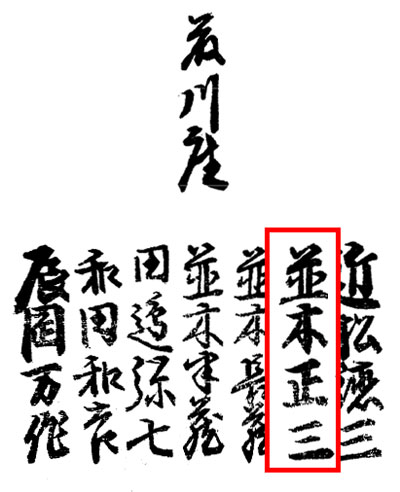| NAMIKI SHďZď II |
|
Playwright names:
Stage name:
Line number: NIDAIME (II) Existence: ??? ~ 25th day of the 7th lunar month of 1807 [1] Connection: Masters: Asao Tamejűr˘ I, Namiki Sh˘z˘ I Career: Before 1773: son of a shibai jaya owner in the D˘tonbori in ďsaka. He was a relative of Namiki Sh˘z˘ I's wife. He became a disciple of Namiki Sh˘z˘ I and received the name of Namiki Sh˘kichi. 17th day of the 2nd lunar month of 1773 [2]: his master Namiki Sh˘z˘ I died. 1770s ~ 1780s: he became actor and a disciple of Asao Tamejűr˘ I. His stage name was Asao Sh˘z˘. 9th lunar month of 1785: he took back the name of Namiki Sh˘kichi and worked as a zamoto in ďsaka. 11th lunar month of 1787: he took the name of Namiki Sh˘z˘ II and worked as a sakusha, along with the tatesakusha Tatsuoka Mansaku, in Ky˘to at the Nishi no Shibai on the kaomise drama "Koko ni Kiwamaru Gojin no Sonae". 2nd lunar month of 1788: premiere at the ďnishi no Shibai of the drama "Gishinden Yomikiri K˘shaku". A drama written by Nagawa Shimesuke I, Sh˘z˘, Tatsuoka Mansaku and Shimada Tsuruz˘. It was supposed to be staged first in Ky˘to at the beginning of the month at the Nishi no Shibai but the theater was destroyed by fire the 29th day of the 1st lunar month. The troupe went to ďsaka to perform at the ďnishi no Shibai and to celebrate the shűmei of Kataoka Nizaemon VII. End of the 1780s ~ beginning of the 1790s: Sh˘z˘ worked mainly in hama shibai. 11th lunar month of 1794: Sh˘z˘ worked at the Naka no Shibai, along with Nagawa Shimesuke I and Nagawa Kunisuke, on the kaomise drama "Kana Utsushi Azuchi Mond˘" [3]. 11th lunar month of 1795: Sh˘z˘ worked with Chikamatsu Tokuz˘ and Tatsuoka Mansaku on the kaomise drama "Ichiban Yari T˘kai Suzuri", which was produced by Fujikawa Hachiz˘ III (who celebrated his shűmei) at the Kado no Shibai; others main actors were Nakayama Bunshichi II, Sawamura Kunitar˘ I, Arashi Hinasuke II, Arashi Koroku III, Nakayama Bungor˘ I, Yoshizawa Iroha I, Mimasu Matsugor˘ I, Yamamura Giemon II, Yamamura Tomoemon I and Asao Sennosuke. 4th lunar month of 1796: premiere at the Kado no Shibai of the drama "Hade Kurabe Ishikawa-zome", written by Chikamatsu Tokuz˘, Tatsuoka Mansaku and Sh˘z˘ [more details]. 7th lunar month of 1796: premiere of the play "Ise Ondo Koi no Netaba", which was written by Chikamatsu Tokuz˘, Tatsuoka Mansaku and Sh˘z˘ in ďsaka at the Kado no Shibai [casting]. 10th lunar month of 1796: Sh˘z˘ worked at the Minamigawa no Shibai, along with Tatsuoka Mansaku, on the kaomise drama "Ebisu Daikoku Megumi no Kurairi", which starred Ichikawa Danz˘ IV, Yamashita Kinsaku II, Asao Tamejűr˘ I, Nakayama Bunshichi II, Anegawa Shinshir˘ III, Yamashita Yaoz˘ I, Fujikawa Tomokichi I and Ichikawa Danzabur˘ IV. The troupe moved to the Naka no Shibai in ďsaka in the 11th lunar month to perform the same program for 10 days. 11th lunar month of 1803: Sh˘z˘ worked at the Kado no Shibai, along with Chikamatsu Tokuz˘, Nagawa Tokusuke I and Segawa Jok˘ II, on the kaomise drama "Hatsu Yagura Kogane no Manmaku", which was produced by Nakamura Noshio III. The troupe moved to the Kita no Shinchi Shibai in the 12th lunar month to perform the same program for 10 days. 7th day of the 4th lunar month of 1804: his master Asao Tamejűr˘ I died. 11th lunar month of 1805: Sh˘z˘ worked at the Minamigawa no Shibai on the revival of "Yoshitsune Senbon Zakura", which starred Nakamura Utaemon III, Band˘ Hikosabur˘ III, Arashi Sangor˘ III, Asao Kuzaemon I, Ichikawa Ichiz˘ I, Asao Tamejűr˘ II, Ogawa Kichitar˘ III, Asao Kunigor˘ III, Nakayama Shinkur˘ III, Yoshizawa Iroha I, Fujikawa Tomokichi I, Nakamura Daikichi I, Nakamura Kumetar˘ II, Fujikawa Katsujir˘, Yoshizawa Sakinosuke IV and Nakamura Motoz˘. The troupe moved to the Naka no Shibai in the 12th lunar month to perform the same program. 25th day of the 7th lunar month of 1807 [1]: Sh˘z˘ died. Comments: Namiki Sh˘z˘ II was a Kamigata sakusha and a relative of the more prominent playwright Namiki Sh˘z˘ I. Though none of his surviving plays were prominent ones, he was said to be the author of "Kezairoku", a Kabuki playwriting manual which was published in 1801. His most notable contribution was his participation in the creation of "Ise Ondo Koi no Netaba" under the supervision of Chikamatsu Tokuz˘ and Tatsuoka Mansaku. [1] The 25th day of the 7th lunar month of the 4th year of the Bunka era was the 28th of August 1807 in the western calendar. [2] The 17th day of the 2nd lunar month of the 2nd year of the An'ei era was the 9th of March 1773 in the western calendar. [3] This kaomise program was divided into two dramas, an afternoon drama entitled like the program and an evening program which was entitled "Atarimasu Yuki-mo Hikikata".
The name of Namiki Sh˘z˘ II in a 1796 ďsaka hy˘banki (the name within the red box); all the names were the sakusha at the Kado no Shibai (the most important ones being Chikamatsu Tokuz˘ and Tatsuoka Mansaku) The Namiki Sh˘z˘ line of playwrights |
|
|
| Contact | Main | Top | Updates | Actors | Plays | Playwrights | Programs | Links | FAQ | Glossary | Chronology | Illustrations | Prints | Characters | Derivatives | Theaters | Coming soon | News |
